On April 20, 2020, NOAA will join our state and federal partners in observing 10 years after the Deepwater Horizon oil spill — an incident that resulted in the tragic loss of human life and an unprecedented impact to the Gulf’s coastal resources and the people who depend on them. From March 30 to April 20, tune in as we go back in time to the day of our country’s largest marine oil spill, what’s happened since then, and how we’re better prepared for future spills. In our latest blog, Disaster Preparedness Program Chief Kate Wheelock shares the highlights of a career spent in disaster coordination.
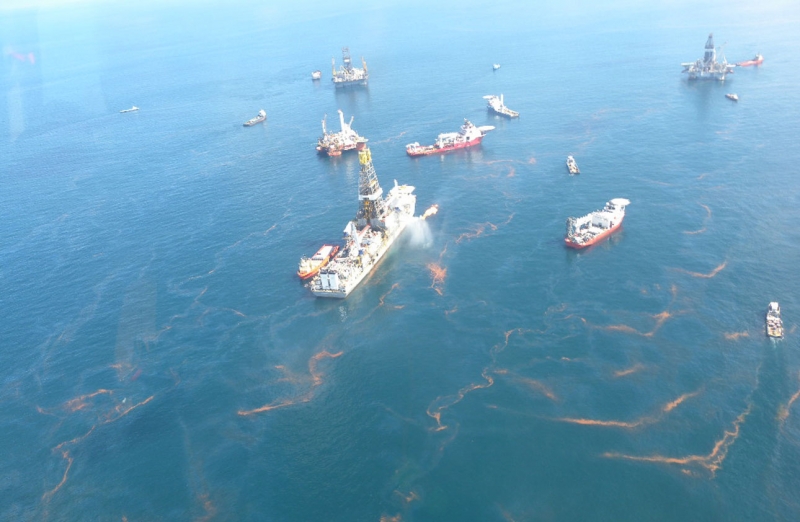
In 2010, before Deepwater Horizon happened, Kate Wheelock was a regional resource coordinator for OR&R’s Assessment and Restoration Division. Based in Rhode Island, she covered the northeast region. On April 21, 2010, Kate had been on her way to an eco-toxicology training in California, watching events unfold on airport televisions. After a day or two in class, and as the magnitude of the disaster became apparent, she was instructed to return home, take 24 hours to pack her stuff and then report to Robert, Louisiana.
In the early days of the incident, Robert had become the base of operations, known as the unified command. Kate reported to the environmental unit in the command, where response was only just ramping up as the focus shifted from the 11 missing crew members of the Deepwater rig, to the still-unravelling pollution concerns.
Kate remembers there weren’t a lot of people in the unified command at that point. The response wasn’t too dissimilar from the other incidents she had experienced throughout her career. People understood this was a very large spill, but no one knew at that point that it would become, or that they were, in fact, working on a spill that would go down in history as the largest marine oil spill in U.S. waters.
Kate spent a two-week rotation in the Robert command as the environmental unit lead. During this rotation at the Robert command, responders were looking into a variety of different methods to help minimize the impact of the oil being discharged from the wellhead until a solution to cap the well could be found. Using aerial dispersants was an approved method for limiting shoreline impacts, but an idea was floated to apply dispersants directly into the wellhead at 5,000 feet and disperse the oil at depth, a method rarely tested before, and never used operationally. As environmental unit lead, Kate was tasked with investigating this approach, organizing and conducting a proof of concept study, and presenting the results for consideration to the National Response Team as a viable option to combat what was to become an 87-day effort to stop the discharge.
Ultimately, the proof of concept study was conducted and the National Response Team approved the use of subsea dispersants as a means of dispersing the oil and largely keeping it from reaching the economic engine of Gulf tourism and fisheries, the shoreline, and estuaries.
An Ongoing Response
In June 2010, after a planned family vacation and a move to Washington D.C. for a one-year developmental assignment, Kate returned to an all hands on deck scenario. She again returned to Louisiana in July as the natural resource damage assessment (NRDA) lead, coordinating and tracking research teams as they went out in the field to do different kinds of resource assessments
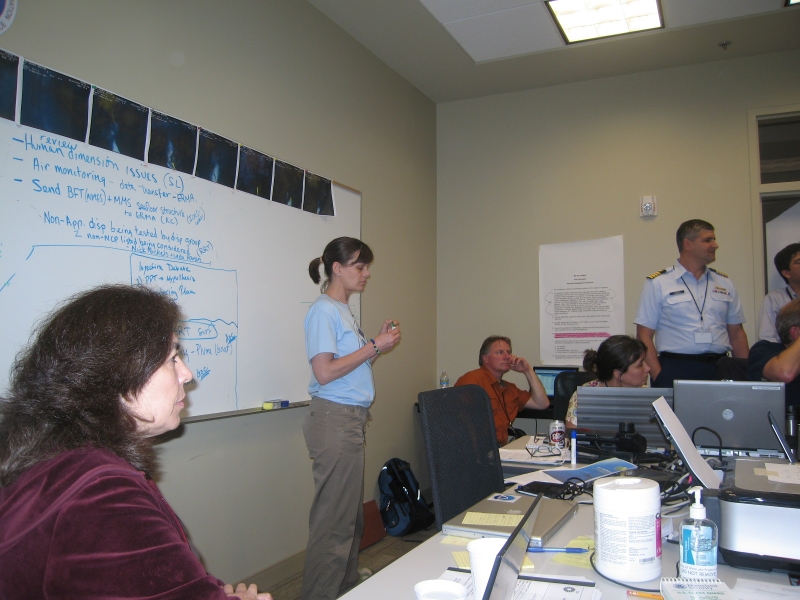
Later that summer when Kate returned home, she reported to the NOAA ‘war room’ in downtown D.C. David Kennedy, the assistant administrator of the National Ocean Service at the time, was managing the war room when he got a call from the policy and research director of the newly established National Commission on the BP Deepwater Horizon Oil Spill and Offshore Drilling asking for a NOAA representative to report the presidential commission immediately to serve as a senior analyst. Having seen Kate’s active role and continued presence in the incident command and NRDA efforts, he selected her to report to the commission. She reported the next day.
During a period of six months, Kate reported only to the commission — doing research for the final report on the potential environmental, economic, and human health damages from the Deepwater incident as well as research on new oil frontiers, which focused on the risks of drilling in the Arctic, an area that several oil companies were eying at the time.
After her work on the commission wrapped up in January 2011, Kate was interested in doing something different back at NOAA, and given her Arctic research with the commission was selected to serve in a detail as the NOAA senior Arctic policy advisor for then Undersecretary Dr. Jane Lubchenko from 2012 to 2013 while Conoco Oil, Shell Oil and Statoil attempted to drill for and extract Arctic oil. Yet her ties to the Gulf soon opened up a new opportunity once again.
Starting a Culture of Preparedness
Kate began her career in Alexandria, Virginia after receiving her undergraduate degree in ocean engineering from the University of Rhode Island. She worked for an environmental consulting company on Department of Defense facility spill containment plans before returning to school at Louisiana State University, where she received her master’s in oceanography and coastal ecology. With a background in spill response planning, her interest in the field led her straight to NOAA, where she worked alongside and was mentored by fellow LSU alumni Charlie Henry, the scientific support coordinator for the Gulf region at the time. After Deepwater Horizon, Charlie Henry went on to serve, and continues to serve, as the director of the Gulf of Mexico Disaster Response Center.
The concept for the Disaster Response Center, Charlie Henry said, goes back to 2005 when Hurricane Katrina devastated the Gulf. It wasn’t uncommon in the aftermath of the hurricane for members of congress to do visits in their home states.
“They realized most of us were working out of tents, Conex boxes, or if we were lucky, trailers,” Charlie said. “So the idea basically came from [Senator] Richard Shelby in Alabama, who saw that what NOAA really needed was a facility that can weather any storm, and then act as a base of operations for the response to the storm.”
When Charlie was first offered the position of acting director for the center, which was still under construction, he was hesitant and somewhat skeptical.
“We weren’t a group that had buildings,” Charlie said, explaining that he saw the role of scientific support coordinators as being flexible, mobile, and adaptable in a way that a physical structure didn’t necessarily support.
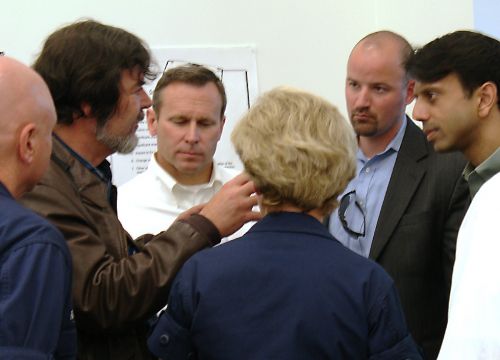
“During [Deepwater Horizon], I began to see a lot of where we weren’t prepared. I saw that across the organization, where NOS had a culture of response, but a lot of other groups throughout the agency didn’t. And I really started to buy into the concept that the real role of this center is to act in this creating of a cultural change focused on preparedness planning. Where you develop plans, you equip your plans, you practice them, and you reevaluate your plans based on how they went,” Charlie said.
When Hurricane Harvey was preparing to come on shore in 2017, Charlie had already set up an incident management team in the National Ocean Service in the hopes of creating a more strategic means for incident coordination. Charlie wanted to further expand OR&R’s role in providing disaster coordination throughout NOS. After a call to Kate, their shared vision led them on a path to something bigger.
“When Harvey was coming ashore, it was really the right place at the right time,” Kate said. “We were already talking about how to boost the Disaster Response Center, and find that broader national voice for it. We just didn’t know what that would look like, but it crystalized with [hurricanes] Harvey, and then Irma, and then Maria.”
As the center continued to grow and find its place in both the Office of Response and Restoration and the National Ocean Service, both Charlie and Kate, OR&Rs chief of staff at the time, began to rethink their business model. They worked with OR&R leadership to develop a vision for how the mission of the Disaster Response Center could be the foundation for an entire program. And at the helm of that program, a management position poised to expand the program to the heart of NOAA at the headquarters in Silver Spring, Maryland.
In 2017, a formidable hurricane season put the vision for the new program to the test. At that time, Kate — now a professional detailee! — was detailed to a four month position as acting NOS chief of staff. As Hurricane Harvey grew off-shore, she got a call from Charlie Henry who said they needed to activate the NOS Incident Management Team. Though the team existed, it wasn’t regularly activated and membership was outdated. Kate and Charlie quickly reinvigorated the team with new and old members to begin collecting situational awareness for the monster bearing down on Texas.
“When it happened, Kate stood up and took control as the management position for NOS,” Charlie said. “Our team was in place, we started collecting some data, and she was great in helping filter what we needed and how to position NOAA and NOS for success.”
The 2017 hurricane season, Charlie said, was when the emerging program’s value really became recognized. In November of 2017, Kate was selected to serve as the acting chief of the Disaster Preparedness Program, a position she now holds permanently.
Preparing for Tomorrow’s Disasters Today
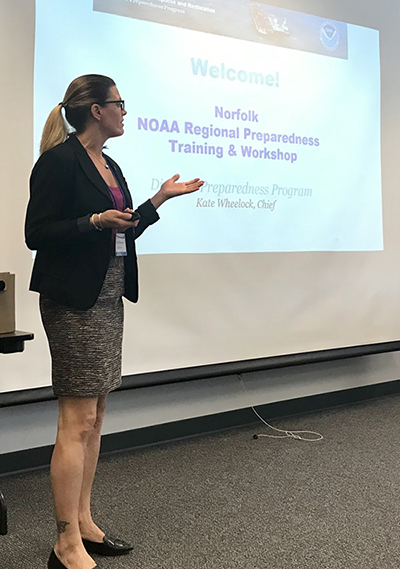
As NOAA continues to grow its preparedness posture for responding to future disasters, we often look back at past events as learning opportunities for how we could have done better with the right tools and information. New tools and advances in science continue to improve our response capabilities, but improving our ability to coordinate and work together during disasters is also important.
The Disaster Preparedness Program has a trigger point of activating for coordination within NOS whenever two or more program offices within the National Ocean Service are responding.
“So the question is, would that be necessary for a large event like this [Deepwater Horizon]?” Kate said, “We’ve really set up a process now that works no matter what the response is. It’s just a different set of subject matter experts.”
Kate said in a situation like Deepwater, the Incident Management Team wouldn’t mobilize to the incident command but would provide coordination and situational awareness remotely. They would set up a “dashboard,” an internal online site to house updates, situation reports, and a wide array of other information from across the various NOS program offices involved.
“During Deepwater, I went directly to the war room, but now we have the Homeland Security Program Office, and the National Ocean Service has this Incident Management Team, so our internal mechanisms have really improved,” Kate said.
Looking back at how incident commands have improved over the years, Kate said major differences can be found in two of our largest incidents — Deepwater Horizon, and the 1989 Exxon Valdez spill in Alaska, which was the largest in U.S. waters before 2010.
“During Exxon Valdez, your situation was readable on paper products on a corkboard,” Kate said. “They were still using paper products on a corkboard during Deepwater Horizon, but we also had ERMA [the Environmental Response Management Application]. And moving forward, what we may start to see is this move toward situational awareness through electronic dashboard visualization.”
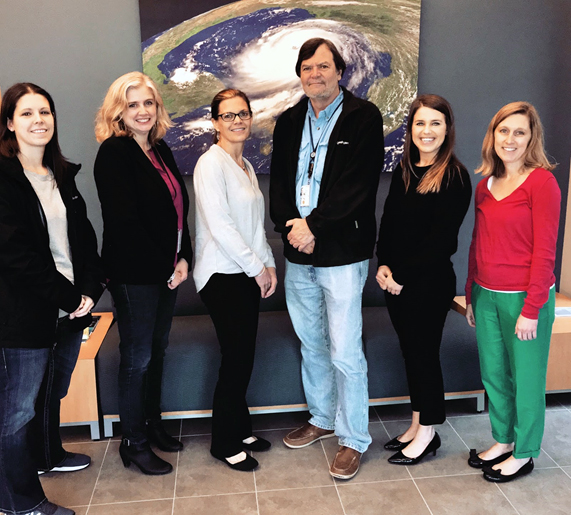
As the Disaster Preparedness Program continues to strengthen the preparedness posture within the National Ocean Service, the capacity of the program continues to grow. What started as a team of four in 2017 has since grown to a team of nine.
“We’ve really expanded the breadth and depth of the work we do,” Kate said. “It’s just such a good team. People have really bought into the mission and the value of our program has been recognized outside of OR&R as something that adds value to both NOS and the rest of NOAA.”
